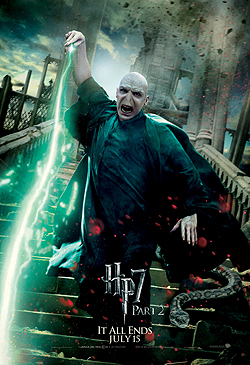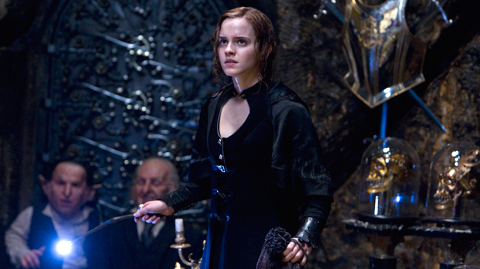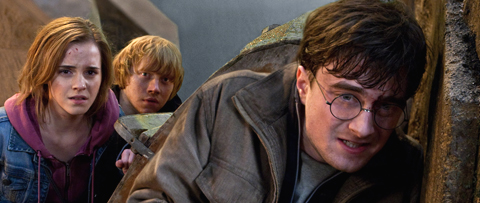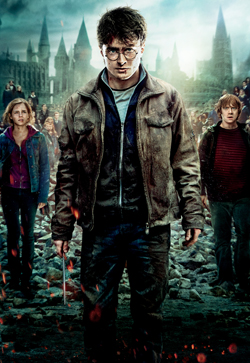 Brilliant. If there's one word to describe the Harry Potter phenomenon, it is "Brilliant." The last installment of the magical film franchise, HARRY POTTER AND THE DEATHLY HALLOWS PART 2, closes the final chapter - and epilogue - of the most successful book and film series in history. We've followed Harry through seven movies over the last decade, a Grawp-sized seventeen-plus hours of film, to learn what we already knew - only one can live. Does the finale live up to the hype? At this point, how could it falter? HARRY POTTER AND THE DEATHLY HALLOWS PART 2 barrels down the tracks like the Hogwart's Express, a sure-fire hit with millions of loyal fans. The final film is even in 3D, complete with special commemorative Harry Potter 3D glasses.
Brilliant. If there's one word to describe the Harry Potter phenomenon, it is "Brilliant." The last installment of the magical film franchise, HARRY POTTER AND THE DEATHLY HALLOWS PART 2, closes the final chapter - and epilogue - of the most successful book and film series in history. We've followed Harry through seven movies over the last decade, a Grawp-sized seventeen-plus hours of film, to learn what we already knew - only one can live. Does the finale live up to the hype? At this point, how could it falter? HARRY POTTER AND THE DEATHLY HALLOWS PART 2 barrels down the tracks like the Hogwart's Express, a sure-fire hit with millions of loyal fans. The final film is even in 3D, complete with special commemorative Harry Potter 3D glasses.
For Harry literalists, the final film strays flagrantly from the text. The story blasts through Gringotts, quickly nods to the complex back stories of Aberforth Dumbledore and Helena Ravenclaw and hardly mentions the Carrows. It races to get to the climactic battle of Hogwarts. Once there, the final duels are altered too. We don't get to see brutal battles between Bellatrix versus Hermione, Luna and Ginny, or the Dark Lord versus McGonagall, Slughorn and Kingsley. Percy never replays the prodigal son. Neville never dons the flaming sorting hat. Grawp never cries "HAGGER" nor does Kreacher lead the siege from the house-elves of Hogwarts (although Hermione's Society for the Promotion of Elfish Welfare was excised from the films way back in the GOBLET OF FIRE, so that wasn't really expected). The ultimate fate of the Elder Wand is quite different in the film, which might create problems if Rowling would bless her fans with an eighth volume.

But in the end, it doesn't matter. If you want literality, be literate and read J. K. Rowling's wonderful books. With over 400 million wrist-breaking volumes sold, Rowling expelliarmus-ed a generation of Twitter-crippled attention spans with a magnificent victory for teenage literacy. The true power behind her intricately-actualized Wizarding world is her mastery of detail and back story; that's just far too complex to translate completely to celluloid.
Redemption lies in the stellar cast which includes many of the finest British thespians today. Ralph Fiennes seethes so menacingly as the nasally-challenged Lord Voldemort, especially notable as Fiennes has a very distinguished sniffer in real life. Helena Bohnam Carter vamps it up over the top as Bellatrix, yet still captures Hermione's teenage awkwardness when under polyjuice potion. Alan Rickman's sharply-clipped delivery makes each of his lines cut deep, yet there isn't a dry eye in the house as the audience plunges into Snape's memory through the pensieve. And when Dame Maggie Smith strays from the book to confess her delight in finally casting the Piertotum Locomotor spell, the audience giggles at her everlasting portrayal of the regal Professor McGonagall. But it all comes down to the three - the three luckiest actors in the world: Daniel Radcliff, Emma Watson and Rupert Grint. We've watched these performers grow up and into their iconic characters. They have matured before the world from cute children into true actors. And we can only wish them well, hoping they overcome their typecast characters better than Elijah Wood or Leonard Nimoy. Even if they don't, they've already had the roles of a lifetime.

But what does Harry Potter have to do with kung fu? Fight scenes throughout the series have been wand battles. If anything, fight choreography has been based on western fencing, especially apparent in CHAMBER OF SECRETS when Lockhart dueled Snape on a raised piste. Unlike many other great fantasy franchises, which have ample swordplay (who can forget Yoda busting wushu moves or Darth Maul's portrayal by wushu champion Ray Parks?), Harry Potter only has one notable sword, the sword of Gryffindor. And while that sword plays a crucial role, there's no butterfly kicks or aerials. In Kung Fu Tai Chi's September October 2010 issue, we launched a new column, Chollywood Rising. Chollywood, a slang derived from Chinese Hollywood, refers to the growing Chinese film industry. Chollywood encompasses both films currently being made in China and Hollywood films playing in China. With the release of HARRY POTTER AND THE DEATHLY HALLOWS PART 2, there will be countless reviews and comments on Harry. Here's one straight from the dragon's lair flying out like a Chinese Firebolt.
 Harry Potter and the Chinese Empire
Harry Potter and the Chinese Empire
Translated into 67 languages, the Harry Potter book series is a global phenomenon. Translated as ?Ha-li Bo-te,? (哈利波特) a phonetic translation in which the four consecutive characters mean "laughter, profit, waves and special" both ironically and nonsensically. Harry's film franchise has done amazingly well in China. With the exception of the third film, the Potter franchise shows the steady climb of returns in China, an interesting barometer of the progression of the Chinese film market. According to BoxOfficeMojo.com, Harry Potter's most recent efforts did quite well in China. DEATHLY HALLOWS PART 1 (2010) grossed over $33 million, the sixth biggest foreign box office take behind (in order) the United Kingdom, Japan, Germany, France and Australia. When James Cameron's AVATAR (2009) earned its second highest foreign box office in China, the world really took notice of China's film receipts. Oddly, there are no Chinese returns posted at BoxOfficeMojo for HALF BLOOD PRINCE (2009), but the-leaky-cauldron.org reported it at over $24 million, and that while the film was still in theatrical distribution. ORDER OF THE PHOENIX (2007) did well at over $19 million, ranking 10th outside of the United States. GOBLET OF FIRE (2005) delivered $11 million, PRISONER OF AZKABAN (2004), $2.5 million and CHAMBER OF SECRETS (2002), $6 million. There are no box office results for China for the SORCEROR'S STONE (2001) either.
It might surprise you to know that China has more Harry Potter books than the rest of the world. China, with little respect for copyright laws, has produced a multitude of Harry Potter rip-off books. Several are allegedly mash-ups of other works, such as J.R.R. Tolkien's LORD OF THE RINGS, where characters like Gandalf appear alongside Harry and other characters are swapped out for J.K. Rowling's creations. Others are alternate tales, marginally tied to the Harry Potter Wizarding World. One claims to be an alternate ending, written by an irate Chinese reader who had issues with Rowling's conclusion in THE DEATHLY HALLOWS. Among these illegal titles are such dubious works as: Harry Potter and the Big Funnel, Harry Potter and the Chinese Empire, Harry Potter and the Chinese Overseas Students at the Hogwarts School of Witchcraft and Wizardry, Harry Potter and the Chinese Porcelain Doll, Harry Potter and the Crystal Vase, Harry Potter and the Golden Armor, Harry Potter and the Hiking Dragon, Harry Potter and Leopard-Walk-up-to-Dragon, Harry Potter and the Waterproof Pearl, Harry Potter and the Young Heroes, and Rich Dad, Poor Dad and Harry Potter.

Here is where Chollywood falls painfully short of Hollywood. While there's been a dearth of originality in Hollywood filmmaking of late, it can still deliver solid film franchises. China has no notion of a proper franchise. With such little regard for copyright, any franchise is protected from exploitation. In reaction to the success of KUNG FU PANDA 2, Chollywood answered with a blatant rip-off titled LEGEND OF THE RABBIT. The film centers on an overweight, bumbling rabbit that works in a restaurant and must master kung fu to defeat, of all things, an evil panda.
It's not that China lacks great storytelling. Recently, the 14th century epic, ROMANCE OF THE THREE KINGDOMS, a tale full of sword and sorcery, was translated to the silver screen. But here again, China filmmakers fight themselves, trying to coattail on other productions instead of establish a franchise integrity. Sammo Hung tackled a few chapters in THREE KINGDOMS: RESURRECTION OF THE DRAGON (2008). That same year, John Woo released part one a triumphant two-part blockbuster RED CLIFF. Part two was released the following year. The two films were condensed into one for limited U.S. release in late 2009. THE LOST BLADESMAN was just released, starring Donnie Yen, who seems on a march to portray all the great martial heroes. Just prior to starring as Guan Yu, the patron saint of martial arts, in BLADESMAN he played the Bruce Lee hero Chen Zhen, and next he moves on to Monkey King. In many ways, ROMANCE OF THE THREE KINGDOMS is the opposite of the Harry Potter franchise. Instead of having a consistent cast (for the most part) depict a contemporary work, this is multiple interpretations of a classic. There are other great Chinese book series, such as the copious contemporary writings of Jin Yong, but nothing parallels Rowling. Nothing even comes close.

What China needs to create a franchise is consistent quality. While China has a few name brands that are gaining in global notoriety such as Feiyue shoes and Li-Ning sportswear, the notion of a global franchise still alludes them, and there's nothing close to comparable in their film production. Chollywood has a long way to go before it can even begin to aspire to the international cinematic power that is Harry Potter.
![]() Print Friendly Version of This Article
Print Friendly Version of This Article
















